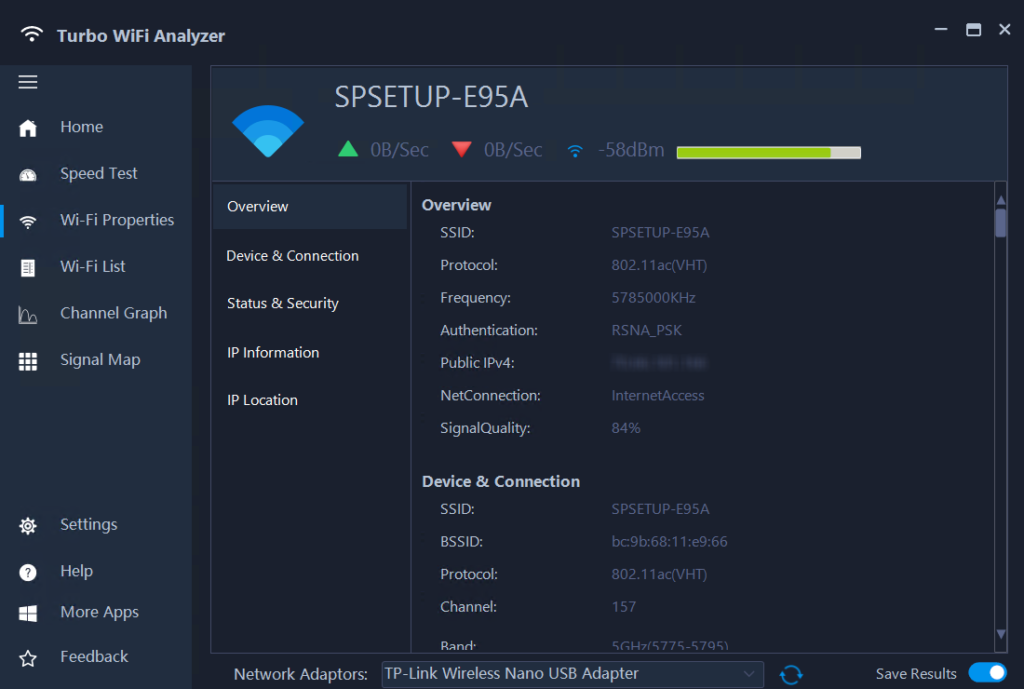Turbo WiFi Analyzer provides a wealth of comprehensive information about your WiFi adaptor and network, categorized into four groups: Devices & Connection, Status & Security, IP Information, and IP Location. Let’s delve into the detailed information each group offers.
Device & Connection:
The “Device & Connection” section of the “Wi-Fi Properties” module provides key information about your Wi-Fi network’s attributes and properties. It includes details such as the SSID, BSSID, protocol, channel, band, bandwidth, frequency, net type, download rate, and upload rate.
- SSID: The Service Set Identifier (SSID) is the unique name assigned to your Wi-Fi network. It helps identify and differentiate your network from others in the vicinity.
- BSSID: The Basic Service Set Identifier (BSSID) is the MAC address of the access point or router that provides the Wi-Fi network. It serves as a unique identifier for the network’s hardware.
- Protocol: The protocol represents the wireless communication standard used for your Wi-Fi connection, such as 802.11a, 802.11b, 802.11g, 802.11n, or 802.11ac.
- Channel: The channel refers to the specific radio frequency channel being utilized by your Wi-Fi network. Different channels allow for multiple networks to coexist without interference.
- Band: The band indicates the frequency band used by your Wi-Fi network, typically 2.4 GHz or 5 GHz. It affects the range, speed, and congestion of the network.
- Bandwidth: Bandwidth refers to the maximum data transfer rate supported by your Wi-Fi network. It determines how much data can be transmitted within a given time frame.
- Frequency: The frequency denotes the specific radio frequency at which your Wi-Fi network is operating. It is measured in hertz (Hz) and determines the speed and range of the network.
- Net Type: The net type describes the type of network being used, such as Wi-Fi or cellular data. It helps identify the nature of the connection.
- Download Rate: The download rate indicates the speed at which data can be downloaded from the internet to your device through the Wi-Fi connection. It is measured in units like megabits per second (Mbps).
- Upload Rate: The upload rate represents the speed at which data can be uploaded from your device to the internet using the Wi-Fi connection. It is also measured in units like megabits per second (Mbps).
Status & Security
The “Status & Security” section within the “Wi-Fi Properties” module provides important details about the status and security aspects of your Wi-Fi connection. It includes attributes such as RSSI, signal quality, connectability, non-connectable reasons, encryption type, authentication type, and runtime.
- RSSI: RSSI stands for Received Signal Strength Indicator, which measures the signal strength of your Wi-Fi connection. It indicates the power level of the received signal, helping assess the signal’s quality.
- Signal Quality: Signal quality represents the strength of your Wi-Fi signal relative to its maximum potential. It is usually expressed as a percentage, providing an indication of the signal’s overall strength.
- IsConnectable: This attribute indicates whether your Wi-Fi network is currently connectable or not, based on its configuration and availability.
- NotConnectableReason: If your Wi-Fi network is not connectable, this attribute provides the reason or explanation for the non-connectivity status.
- Encryption Type: Encryption type refers to the security protocol used to protect your Wi-Fi network. It ensures that transmitted data remains private and secure. Common encryption types include WEP, WPA, and WPA2.
- Authentication Type: Authentication type refers to the method used to verify the identity of devices connecting to the Wi-Fi network. It ensures that only authorized devices can access the network. Common authentication types include Open, WPA-PSK, and WPA2-PSK.
- Runtime: The runtime attribute displays the duration for which your Wi-Fi connection has been active or running continuously.
IP Information
The “IP Information” section within the “Wi-Fi Properties” module presents essential details about the IP (Internet Protocol) configuration of your Wi-Fi connection. It includes attributes such as public IPv4 address, IPv4 address, IPv4 mask, IPv4 gateway, IPv4 DHCP, IPv4 DNS, IPv6 address, IPv6 temporary address, IPv6 link local address, IPv6 gateway, and IPv6 DNS.
- Public IPv4 Address: This attribute displays the public IPv4 address assigned to your Wi-Fi network, which is the unique identifier used to communicate with devices and services over the internet.
- IPv4 Address: The IPv4 address represents the specific address assigned to your device within the local network. It allows for communication with other devices within the same network.
- IPv4 Mask: The IPv4 mask, also known as the subnet mask, determines the size of the network and identifies the range of IP addresses within the local network.
- IPv4 Gateway: The IPv4 gateway denotes the IP address of the router or gateway device that connects your local network to the wider internet.
- IPv4 DHCP: DHCP (Dynamic Host Configuration Protocol) is responsible for automatically assigning IP addresses and network configuration to devices within the network. The IPv4 DHCP attribute displays the DHCP server’s IP address.
- IPv4 DNS: DNS (Domain Name System) translates domain names into IP addresses. The IPv4 DNS attribute shows the IP address of the DNS server responsible for resolving domain names to IP addresses.
- IPv6 Address: IPv6 address is the next-generation Internet Protocol address format. This attribute displays the unique IPv6 address assigned to your device within the network.
- IPv6 Temporary Address: IPv6 temporary address is a temporary and privacy-oriented IPv6 address that helps protect your device’s identity and location.
- IPv6 Link Local Address: The IPv6 link local address is used for communication within the local network, allowing devices to communicate without the need for a global IPv6 address.
- IPv6 Gateway: The IPv6 gateway represents the IP address of the router or gateway device that connects your local IPv6 network to the wider IPv6 network.
- IPv6 DNS: Similar to IPv4 DNS, the IPv6 DNS attribute shows the IP address of the DNS server responsible for resolving domain names into IPv6 addresses.
IP Location
The “IP Location” section within the “Wi-Fi Properties” module provides geographic information related to the IP address of your Wi-Fi connection. It includes attributes such as continent, country, region, city, zip code, latitude, and longitude.
- Continent: The continent attribute specifies the continent where your Wi-Fi connection’s IP address is geographically located.
- Country: The country attribute indicates the country where your Wi-Fi connection’s IP address is registered.
- Region: The region attribute represents the specific region or state within the country where your Wi-Fi connection’s IP address is situated.
- City: The city attribute specifies the city or locality associated with your Wi-Fi connection’s IP address.
- Zip Code: The zip code attribute displays the postal code or ZIP code related to your Wi-Fi connection’s IP address location.
- Latitude: The latitude attribute denotes the geographic latitude coordinate of your Wi-Fi connection’s IP address location.
- Longitude: The longitude attribute represents the geographic longitude coordinate of your Wi-Fi connection’s IP address location.







